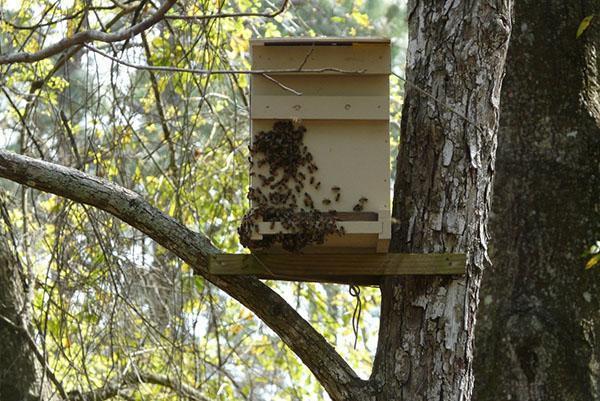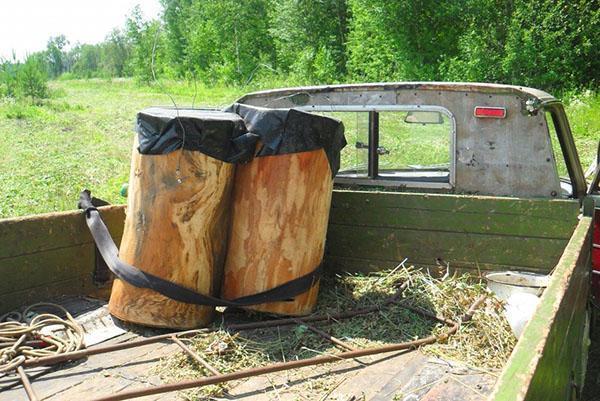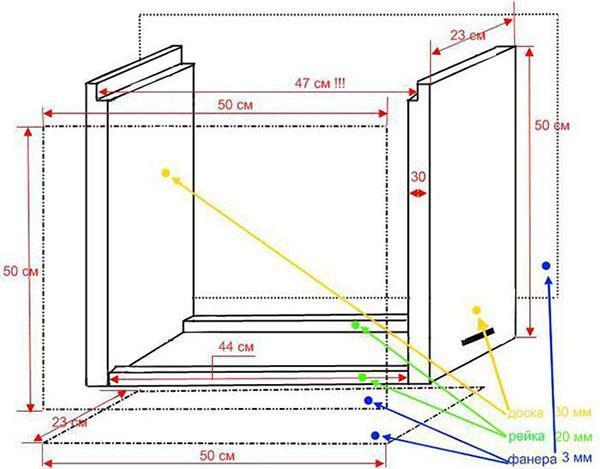Bee trap: manufacturing and installation locations
 The departure of a swarm by beekeepers is perceived as a problematic situation, because on the one hand, it is the result of natural reproduction, and on the other, the risk of losing some part of the insects living in apiaries. The bee trap is designed to trap a roving swarm. A simple device resembling a small portable hive is installed in places where bees are likely to be found. And if the beekeeper manages to create conditions that are attractive for insects, then after a comprehensive examination they can inhabit the trap, falling into the hands of a caring beekeeper. Today in apiaries, techniques are held in high esteem to prevent the formation and emergence of swarms. But in some cases this cannot be avoided.
The departure of a swarm by beekeepers is perceived as a problematic situation, because on the one hand, it is the result of natural reproduction, and on the other, the risk of losing some part of the insects living in apiaries. The bee trap is designed to trap a roving swarm. A simple device resembling a small portable hive is installed in places where bees are likely to be found. And if the beekeeper manages to create conditions that are attractive for insects, then after a comprehensive examination they can inhabit the trap, falling into the hands of a caring beekeeper. Today in apiaries, techniques are held in high esteem to prevent the formation and emergence of swarms. But in some cases this cannot be avoided.
Swarming can occur for a variety of reasons, including not only the growth of a bee colony, when the old queen with a part of the worker bees leaves in search of new housing. The increased risk of swarms flying out is observed in hot years when there is not enough bribe, as well as when keeping families in too cramped conditions.
How does a bee trap work? Can you do it yourself, and where to put it so that the probability of being caught is the greatest?
How to make a bee trap?

How to make a do-it-yourself bee trap correctly? There are tons of accurate, verified blueprints and layouts of temporary swarm shelters in open sources. Starting an independent work, the beekeeper must remember that whatever the structure, it must be sufficient to accommodate the bee colony, but at the same time suitable for carrying and erecting on a tree. Therefore, the volume of the trap is most often limited to 30–60 liters.
 Of the existing options, vertical structures resembling a hollow are preferred. As a material for construction, low-resinous varieties of well-dried wood, plywood, chipboard are applicable. And building materials and means for their fastening and gluing should not have harsh odors that frighten off bees.
Of the existing options, vertical structures resembling a hollow are preferred. As a material for construction, low-resinous varieties of well-dried wood, plywood, chipboard are applicable. And building materials and means for their fastening and gluing should not have harsh odors that frighten off bees.
Additional attractiveness to the trap is given by rubbing the entrance and internal surfaces with Apira, propolis, lemon balm or basil. Experienced beekeepers stock up on bark, which is used to upholster or paste over the surface of a plywood, fiberboard or wood bee trap.
What is the exterior and interior of a bee trap? Outside, a temporary shelter for a swarm looks like a box closed on all sides with one tap hole, equipped with a strong damper or latch. Inside, the beekeeper places frames with honeycombs and foundation, and a method must be provided for removing them from the trap for transfer to a permanent hive. For transporting the structure, strong belts are often attached to the traps.
 The key to successfully creating a do-it-yourself bee trap is the design drawings. If they are accurate and designed by an expert, construction will not take much time and will not cause difficulties even for a novice beekeeper.
The key to successfully creating a do-it-yourself bee trap is the design drawings. If they are accurate and designed by an expert, construction will not take much time and will not cause difficulties even for a novice beekeeper.
In addition to a proven accurate drawing, to create a do-it-yourself bee trap you will need:
- plywood with a thickness of at least 4 mm or dried boards 20 mm;
- bars 20 by 20 mm;
- foam for construction insulation;
- material to protect the trap cover from moisture penetration;
- nails, as well as all the tools necessary for the work.
The work begins with the procurement of all the details of the bottom and the body of the bee trap made according to do-it-yourself drawings:
- The body and the bottom are connected without gaps, but at the same time we must not forget about the arrangement of the tap hole. It is made on the front wall so as to provide unhindered access to one insect. More often, a slot 100 mm wide and 10 mm high is provided as a taphole.
- The frame in the corners is fastened with bars, the same slats with grooves are stuffed along the top of the side walls to install the frames.
- The part of the cover is cut out a little more than the dimensions of the body, while the bars that make up the edging must be fastened so that the connection of the cover to the body is as tight as possible.
- The inner surface of the cover is insulated with a layer of foam. The outer part is upholstered with a dense moisture-proof film or roofing felt.
- Then the lid is attached to an almost finished plywood or wood bee trap.
- In order to avoid delamination and deformation of the material from moisture, temperature changes, the body, bottom and lid must be treated with linseed oil and thoroughly dried. After that, it is possible to paint the trap in subtle, masking colors.
- Convenient straps, loops or handles must be provided to carry the box and fasten it to a tree or stand.
- Frames are installed in the finished bee trap. Their number varies depending on the design and size of the structure. There must be 1 2 frames with honeycombs in front, and then foundation is already placed.
 The bark, harvested in advance, cleaned from possible pests, is upholstered on the body and roof of the trap. In this form, the box will less attract the attention of uninvited guests, but the bees with great pleasure will inspect and master the dwelling presented to them.
The bark, harvested in advance, cleaned from possible pests, is upholstered on the body and roof of the trap. In this form, the box will less attract the attention of uninvited guests, but the bees with great pleasure will inspect and master the dwelling presented to them.
A video about bee traps and how to build this device with your own hands will be a useful help for novice beekeepers who want to replenish the population of their farm without spending serious money.
Choosing a place and time to install a bee trap
By carefully observing the behavior of his charges, an experienced beekeeper can, with a high degree of probability, indicate the places where his bee trap will definitely work.
The best place to set the trap is in a sturdy tree at the edge of a forest or in a garden that has a clean drinking pond nearby. Bees fully lit areas without a hint of shadow are not suitable. The bee trap should always be located on the south side.
The height of the trap may vary, but beekeepers advise against placing the box higher than 6–8 meters.
If the swarming bees do not fly away far from the backyard, the trap can be placed in places where they often settle. An example is the raspberry tree, the trunk of a strong apple tree growing in the courtyard of a pine or spruce, the roof or eaves of a residential building or barn. The only condition for this is remoteness from power lines, which insects do not favor.
There should be places for collecting honey near the installed trap or the box should be mounted on trees famous for active flowering. It can be acacia, apple, chestnut, pear, large plum and apricot trees, as well as willows and other species of willow that give the first bribes.
 When to set a trap for bees so that the probability of a swarm settling in it is maximized? It is best to carry out this operation for a couple of weeks before the average departure of swarms in the region. During this time, the scout bees will already have time to inspect all objects suitable for life, as evidenced by the presence of individual insects in the trap and traces of their vital activity.
When to set a trap for bees so that the probability of a swarm settling in it is maximized? It is best to carry out this operation for a couple of weeks before the average departure of swarms in the region. During this time, the scout bees will already have time to inspect all objects suitable for life, as evidenced by the presence of individual insects in the trap and traces of their vital activity.